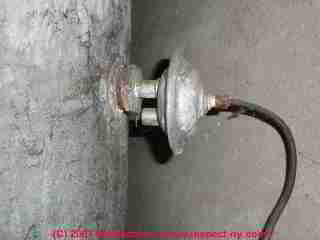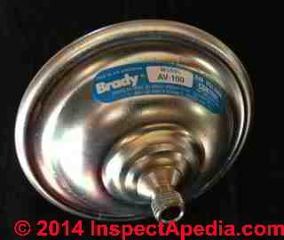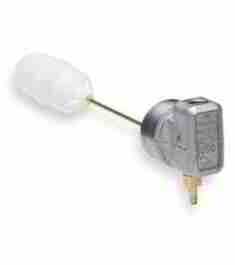 Water Tank Air Volume FAQs-2
Water Tank Air Volume FAQs-2
Q&A on pressure tank AVCs
- POST a QUESTION or COMMENT about air volume controls on water tanks: how they work, why they are needed, and how to fix, repair, replace, or abandon an AVC that is not working, hissing, leaking, or just generally making trouble.
Questions & answers about AVCs - air volume controls on water tanks, set #2.
These FAQs help explain, diagnose, repair or install water tank air volume controls (AVCs) used to keep a proper air charge in a water pressure tank and thus avoid well pump turning on and off to frequently.
This article series describes what AVCs look like, we explain the types of air volume controls used on jet pumps and on submersible pumps, and we describe where to find them, and how these devices work, and how they can be repaired, replaced or just abandoned.
InspectAPedia tolerates no conflicts of interest. We have no relationship with advertisers, products, or services discussed at this website.
Water Tank Air Volume Control FAQs

These questions & answers about air volume controls on water pressure tanks were posted originally at WATER TANK AIR VOLUME CONTROLS - be sure to review the definitions, troubleshooting, and repair advice given there.
On 2019-01-08 by (mod) - conventional bladderless pressure tank uses an air pressure adjustment fitting / AVC
That sounds like a conventional air pressure adjustment fitting and what you've done should be perfectly fine without any further modification
On 2019-01-07 by Jim
My water tank does not have an internal bladder.
My air volume control is screwed into the side of the tank and has a float.The shraeder valve is located on the float valve underneath where the pressure gauge is screwed in.
I did notice the shraeder valve I removed had a lighter spring than the automotive one I put on.
That's what made me think it wasn't the right one and you just reassured me. I will be replacing the entire air volume control float tomorrow if I can't buy just the shrader valve for it. Thanks for all the info,,much appreciated.
On 2019-01-07 by (mod) -
I think that repair is safe as you describe it. If the Schrader valve was on the water pressure tank and simply has the job of allowing you to adjust the tank air pressure you can stay with what you have installed.
If on the other hand the Schrader valve was part of a automatic air volume control system mounted perhaps on the water piping near the tank and working in concert with a snifter valve in the well combined with submersible pump and a water pressure tank that does not use an internal bladder.
In that case you may need the correct valve because the spring pressure for the correct valve would be different, most likely less than, and automotive tire valve.
On 2019-01-06 21:58:59.549420 by Jim
The shraeder valve was dripping on my Air Volume Control.I removed the shraeder valve and replaced with a similar shraeder for a tire valve.
The 2 were close but not identical. The water is back on and no longer leaking.
Was wondering if this is safe to do as I've not heard any air going through the valve and the pump has came on and went off a few times.This is most likely a temporary fix so I have water on a Sunday evening. Thanks
On 2018-12-24 21:59:09.408712 by (mod) - Do I need a avc on a new tank thats has a bladder ?
No Trustee.
An internal bladder type water tank keeps the air charge separate from the water - usually the water is in the bladder and the air charge above it. So air isn't absorbed into the water and does not need to be maintained.
On 2018-12-24 21:12:02.901139 by trustee37.mj
Do I need a avc on a new tank thats has a bladder
On 2017-07-15 21:12:33.797750 by (mod) -
Thanks for the helpful comments, Paul.
In general I agree except that there is a variety of AVCs and air volume control designs and not all add minute amounts of air. For example snifter valve systems add quite a large volume of air to the bladderless pressurised tank at each submersible pump on-off cycle. The system depends on a separate air bleeder to remove the excess air from those systems.
On 2017-07-15 15:47:07.556864 by COWBOY PAUL
The ONLY purpose of an Air Volume Control is to add a minute amount of air to a bladderless well tank, every time the pump cycles, to compensate for air absorption by the pressurized water.
On 2017-06-22 08:03:29.761510 by (mod) -
Billy,
Thank you for your comments.
Keep in mind that if your water pressure tank does not use an internal bladder, then it needs some form of air volume control or periodic air recharge.
On 2017-06-22 03:32:00.755719 by Billy
 The post I had with links to pics of the setup didn't go through, so here it is without pics.
The post I had with links to pics of the setup didn't go through, so here it is without pics.
I'm not arguing the normal function of an AVC system. I was conjecturing the improper use of the system in this particular hackjob as a shortcut to remove air from the pipe
such that ground water rises to the intake of the pump rather than methodically removing the pressure gauge, adding water, replacing and sealing the pressure gauge, and cycling the pump multiples times until all air is removed from the impellers and piping as per the manual's instructions.
And that's only if the written steps on the tank "Air in" and "Cut air off" refer to unkinking and kinking the hose that is attached to (what the pump manual calls) the A.V.C. fitting tapping, (which the manual also says is non-essential.)
Or it could just be instructions for draining the tank.
I only thought this shortcut was possible because I don't know where the AVC gets its air supply. If it is physically separate from the other systems, then it should be as you say.
I have, however, found another source that says an AVC bleeds off excess air in the tank rather than injecting air.
Anyway, I've just discovered that the starter capacitor is ruptured and the starter switch is broken. I've replaced them and the pump runs. I'll see if the well itself is still functional after Tropical Storm Cindy passes.
I'll be looking into getting a Cycle Stop Valve, a tank with a bladder, and I'll be glad to get rid of the AVC altogether.
Thanks for your help.
On 2017-06-14 12:25:29.399494 by (mod) -
An air leak at the water pump could cause loss of prime; that would include leaks at an AVC connection at a pump;
Usually the small diameter tubing found at a water pump is not an AVC but rather a tube that conducted water pressure to the sensor of the pressure control switch.
An AVC system itself has nothing to do with pump priming. The AVC inserts air into the pressure tank as a pump cycles on and off and tank water level falls then rises.
On 2017-06-14 03:53:15.919178 by Billy
The steps written on the side of the tank seem like instructions to create suction through the AVC line rather than charge the tank with air
. I was thinking IF it does have something to do with the vacuum as he was told, it could be a priming shortcut draining a tank full of water with it's only air inlet being the AVC port on the pump, potentially drawing the water from the bottom of the well all the way to the pump, then kinking the hose.
But I don't know if the AVC port on the pump is in any way connected to the relevant pipe, which you've said it has nothing to do with priming, so... If I get the pump working, we'll likely get a tank with a bladder.
My dad says the pump motor is burnt up, so I've just fixed some alarming electrical work and added a switch in the same building as the pump for troubleshooting.
I'm hoping that the blackened contacts on the pressure regulator switch was the problem, instead. If that's the case, sitting for 5-6 years hopefully hasn't ruined it.
On 2017-06-13 21:04:54.185775 by (mod) -
Billy,
That's an interesting question. I don't know an absolutely certain answer but that doesn't preclude some speculation:
If you kink the AVC line you are preventing the AVC from keeping the proper air charge in the pressure tank and ultimately the tank's air charge will be lost and the pump will be short-cycling on and off. Short cycling a pump could overheat it and cause it to go off on thermal reset - something somebody might mistake for lost prime.
But the AVC itself has nothing to do with priming the pump.
IF someone installed a different sort of AVC on the water tank then they might well have pinched off the old tube from the pump because that was easier than finding a brass plug that would have fit in the opening where the tubing was connected.
On 2017-06-13 18:00:50.806422 by Billy
My parent's house has a well from the previous owner that uses a Sta-rite multi-stage deep well jet pump and a bladder-less pressure tank.
There is an A.V.C. attached to the tank with an air line running to the base of the pump, but the air line has been intentionally kinked.
My dad said unkinking that line would cause the pump to lose its prime as it has something to do with the vacuum, according to the guy who used to service the well. Is there any obvious reason someone would want the A.V.C. line to be pinched off like that?
Was that simply a cheap way to remove the A.V.C. function from the system? Thank you
On 2016-11-08 19:05:22.364295 by (mod) -
Anon:
I'd sure like to help but don't have enough understanding of your system and the issues. These are huge tanks - for a residential application, suggesting that the water wells are quite marginal in flow rate.
I'm guessing that the snifter valves are not working on your system since in normal operation a well using snifter valves (located on the well piping in the well, in air above the water top) injects so much air into the system that the on-tank snifter valve component (designed to vent excess air) frequently vents *excess* air from the system.
Before installing an add-on compressor and air supply system I'd want a more accurate diagnosis of the problem. Otherwise we're treating the symptom not the cause - an approach that risks wasting money, adding complexity and cost, and that may still prove ineffective.
On 2016-11-07 19:04:35.914670 by Anonymous
Installed two tanks in 1985. one 1000 gallon and the other is 2000 gallons. the 2000 gallon tank is the primary water source. the 1000 is only used in an emergency situation. recently I have been told that I need an automatic air control system installed.
we have the bleeder valves installed at approximately 120 on each well. but its impossible to keep one tank from water logging if both wells run at the same time. both tanks were installed via ncdenr specs and both have the sniffer valve that is installed at the center of the tank.
I am being asked to install the compressor and prob to keep water levels at optimum range
On 2016-06-04 19:45:44.431517 by (mod) -
Perhaps a burst diaphragm.
On 2016-06-04 17:13:44.275496 by Billy Johnston
On the new AVC I just installed water is spraying out of the nipple coming out the back. Not the nipple that screws in .What's going on
On 2016-02-22 22:47:34.770631 by (mod) -
Peggy
Please also search InspectApedia for and read WATER TANK AIR VOLUME CONTROL REPAIR
On 2016-02-22 22:07:40.149492 by (mod) -
Peggy:
Air volume control replacement is basically a bolt-on repair at the water pressure tank, once you've drained pressure and enough water from the tank that you don't get squirted during the removal and replacement.
The following Brady AVC control installation suggestions are a direct quote from the manufacturer whose contact Information I'll give below
1. Check the system for leaks. Your Air Volume Control will not replenish enough air to overcome leaks in the system.
2. Make sure that the side of the control marked “tank side” is closest to the tank. The control will not function otherwise.
3. Your Brady Air Volume Control should be installed into the 1/4” or 3/8” N.P.T. tank port above and closest to the discharge port as shown below.
4. Connecting the tubing (vacuum line) to the suction port located at the center of the control and the suction port on the pump. You Air Volume
Control works on a vacuum principle, so make sure that the tubing connected to the pump is clear and not obstructed or kinked.
5. A snug fit is all that is necessary for all connections. Do not over tighten!
6. For best results and easy installation, use the Brady UK-1 Installation kit.
Contact the manufacturer if you need parts, the installation kit, or more help:
Brady Products Inc.,
2151 Logan Street, Clearwater, FL 33765 U.S.A.
Tel: (727) 443-4508
Brady air volume controls controls are sold at plumbing suppliers and at building supply stores such as Lowes or Home Depot and cost about $35. U.S.
Question: Why Can't I Find the Air Volume Control on My Water Pump or Water Tank?
I've looked all over my water pressure tank for that round disk thingie that you show in the photos in this AVC article but I just can't find it, nor do I see that rectangular version that is sometimes on the tank side. Where is it?
[Click to enlarge any image]
Reply: your well water system may not have an AVC, or the AVC may be hidden on the well piping inside the well
Bladder type water tanks do not use an air volume control valve: Air volume control valves are present only on steel water tanks which do not include an internal bladder to keep water and air separated inside the water tank. In other words, if your water tank is one of the newer models which uses an internal bladder, you won't find an AVC installed.
A bladder-type water tank keeps the air charge separated from the water. The air is in the tank and the water is inside the bladder inside the tank. Thus the air charge does not become lost by absorption into the water.
Details of tanks that use an internal bladder and that do NOT use an air volume controlare
at WATER TANK BLADDERS & CAPTIVE AIR
Hidden AVCs that may be found inside the well are discussed
at Air volume control valves located inside the well
Instructions for replacing an air volume control such as the Brady AVC shown above are
at AIR VOLUME CONTROLS, REPLACE
...
Continue reading at WATER TANK AIR VOLUME CONTROL REPAIR or select a topic from the closely-related articles below, or see the complete ARTICLE INDEX.
Or see these
Recommended Articles
- WATER PUMP SHORT CYCLING
- WATER PUMP SWITCH INSTALLATION MANUALS
- WATER TANK AIR VOLUME CONTROLS
- AIR VOLUME CONTROL ADJUSTMENT
- AIR VOLUME CONTROLS on DRAIN BACK SYSTEMS
- AIR VOLUME CONTROLS ROUND/Tube
- AIR VOLUME CONTROLS RECTANGULAR
- AIR VOLUME CONTROLS FLOAT TYPE
- AIR VOLUME CONTROLS, GET RID OF
- AIR VOLUME CONTROLS, HISSING
- AIR VOLUME CONTROL REPAIR
- AIR VOLUME CONTROLS, REPLACE
- AIR VOLUME CONTROL TEST
- SNIFTER & DRAIN BACK VALVES
Suggested citation for this web page
WATER TANK AIR VOLUME CONTROL DIAGNOSTIC FAQs-2 at InspectApedia.com - online encyclopedia of building & environmental inspection, testing, diagnosis, repair, & problem prevention advice.
Or see this
INDEX to RELATED ARTICLES: ARTICLE INDEX to WATER SUPPLY, PUMPS TANKS WELLS & SPRINGS
Or use the SEARCH BOX found below to Ask a Question or Search InspectApedia
Ask a Question or Search InspectApedia
Try the search box just below, or if you prefer, post a question or comment in the Comments box below and we will respond promptly.
Search the InspectApedia website
Note: appearance of your Comment below may be delayed: if your comment contains an image, photograph, web link, or text that looks to the software as if it might be a web link, your posting will appear after it has been approved by a moderator. Apologies for the delay.
Only one image can be added per comment but you can post as many comments, and therefore images, as you like.
You will not receive a notification when a response to your question has been posted.
Please bookmark this page to make it easy for you to check back for our response.
Our Comment Box is provided by Countable Web Productions countable.ca
Citations & References
In addition to any citations in the article above, a full list is available on request.
- In addition to citations & references found in this article, see the research citations given at the end of the related articles found at our suggested
CONTINUE READING or RECOMMENDED ARTICLES.
- Carson, Dunlop & Associates Ltd., 120 Carlton Street Suite 407, Toronto ON M5A 4K2. Tel: (416) 964-9415 1-800-268-7070 Email: info@carsondunlop.com. Alan Carson is a past president of ASHI, the American Society of Home Inspectors.
Thanks to Alan Carson and Bob Dunlop, for permission for InspectAPedia to use text excerpts from The HOME REFERENCE BOOK - the Encyclopedia of Homes and to use illustrations from The ILLUSTRATED HOME .
Carson Dunlop Associates provides extensive home inspection education and report writing material. In gratitude we provide links to tsome Carson Dunlop Associates products and services.

